Management Accounting: Cost Elements, Costing and Overhead Allocation
VerifiedAdded on 2020/01/23
|12
|2012
|199
Report
AI Summary
This report delves into the core elements of cost accounting, encompassing materials, labor, and overhead. It explores various costing methods applicable to different product scenarios, including manufacturing and averaging techniques. The report explains key cost concepts like prime cost, product cost, and period cost. It also provides a detailed analysis of manufacturing and income statements, including calculations of inventories. Furthermore, it clarifies the treatment of overtime costs and provides journal entries for material control and accrued payroll accounts. The report analyzes payroll calculations for direct and indirect labor, and evaluates the effectiveness of Activity Based Costing (ABC) compared to traditional costing systems. Finally, it examines different methods of overhead allocation, including direct, step-down, and reciprocal methods, providing a comparative analysis of each approach. The report aims to provide a comprehensive understanding of cost accounting principles and their practical applications.
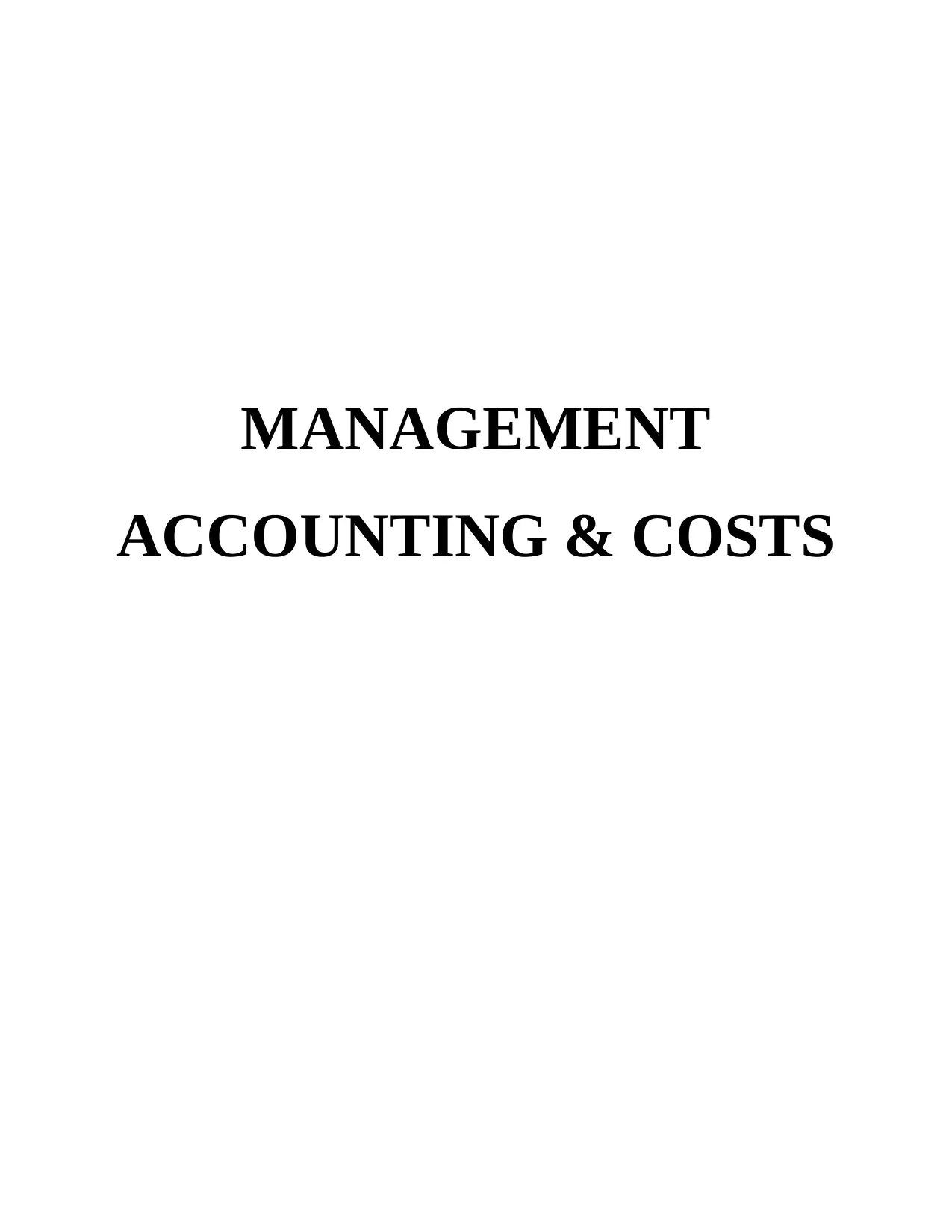
MANAGEMENT
ACCOUNTING & COSTS
ACCOUNTING & COSTS
Paraphrase This Document
Need a fresh take? Get an instant paraphrase of this document with our AI Paraphraser

Table of Contents
INTRODUCTION...........................................................................................................................1
TASK...............................................................................................................................................1
Q.1 Major elements of cost with example..................................................................................1
Q. 2 Costing................................................................................................................................1
Q. 3 Cost concepts.......................................................................................................................2
Q. 4 Manufacturing statement and income statement.................................................................2
Q. 5 Cost concepts......................................................................................................................4
Q.6 Understanding the entries in the Materials Control account ...............................................4
Q. 7 Understanding the entries in the Accrued Payroll account................................................5
Q. 8 Payroll: direct and indirect labour.......................................................................................6
Q. 9 Activity Based Costing........................................................................................................7
Q. 10 Direct, step and reciprocal methods of overhead allocation.............................................8
REFERENCES..............................................................................................................................10
INTRODUCTION...........................................................................................................................1
TASK...............................................................................................................................................1
Q.1 Major elements of cost with example..................................................................................1
Q. 2 Costing................................................................................................................................1
Q. 3 Cost concepts.......................................................................................................................2
Q. 4 Manufacturing statement and income statement.................................................................2
Q. 5 Cost concepts......................................................................................................................4
Q.6 Understanding the entries in the Materials Control account ...............................................4
Q. 7 Understanding the entries in the Accrued Payroll account................................................5
Q. 8 Payroll: direct and indirect labour.......................................................................................6
Q. 9 Activity Based Costing........................................................................................................7
Q. 10 Direct, step and reciprocal methods of overhead allocation.............................................8
REFERENCES..............................................................................................................................10
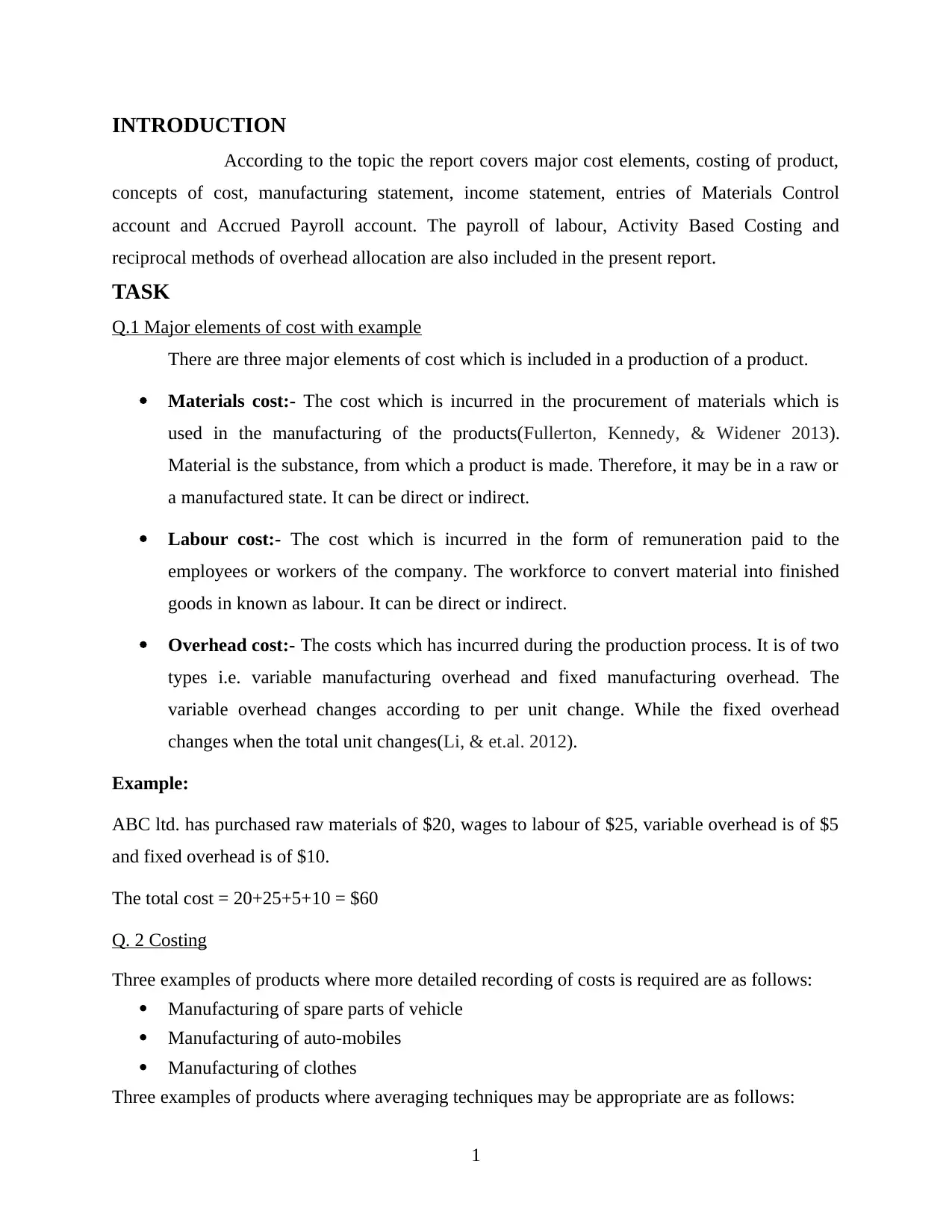
INTRODUCTION
According to the topic the report covers major cost elements, costing of product,
concepts of cost, manufacturing statement, income statement, entries of Materials Control
account and Accrued Payroll account. The payroll of labour, Activity Based Costing and
reciprocal methods of overhead allocation are also included in the present report.
TASK
Q.1 Major elements of cost with example
There are three major elements of cost which is included in a production of a product.
Materials cost:- The cost which is incurred in the procurement of materials which is
used in the manufacturing of the products(Fullerton, Kennedy, & Widener 2013).
Material is the substance, from which a product is made. Therefore, it may be in a raw or
a manufactured state. It can be direct or indirect.
Labour cost:- The cost which is incurred in the form of remuneration paid to the
employees or workers of the company. The workforce to convert material into finished
goods in known as labour. It can be direct or indirect.
Overhead cost:- The costs which has incurred during the production process. It is of two
types i.e. variable manufacturing overhead and fixed manufacturing overhead. The
variable overhead changes according to per unit change. While the fixed overhead
changes when the total unit changes(Li, & et.al. 2012).
Example:
ABC ltd. has purchased raw materials of $20, wages to labour of $25, variable overhead is of $5
and fixed overhead is of $10.
The total cost = 20+25+5+10 = $60
Q. 2 Costing
Three examples of products where more detailed recording of costs is required are as follows:
Manufacturing of spare parts of vehicle
Manufacturing of auto-mobiles
Manufacturing of clothes
Three examples of products where averaging techniques may be appropriate are as follows:
1
According to the topic the report covers major cost elements, costing of product,
concepts of cost, manufacturing statement, income statement, entries of Materials Control
account and Accrued Payroll account. The payroll of labour, Activity Based Costing and
reciprocal methods of overhead allocation are also included in the present report.
TASK
Q.1 Major elements of cost with example
There are three major elements of cost which is included in a production of a product.
Materials cost:- The cost which is incurred in the procurement of materials which is
used in the manufacturing of the products(Fullerton, Kennedy, & Widener 2013).
Material is the substance, from which a product is made. Therefore, it may be in a raw or
a manufactured state. It can be direct or indirect.
Labour cost:- The cost which is incurred in the form of remuneration paid to the
employees or workers of the company. The workforce to convert material into finished
goods in known as labour. It can be direct or indirect.
Overhead cost:- The costs which has incurred during the production process. It is of two
types i.e. variable manufacturing overhead and fixed manufacturing overhead. The
variable overhead changes according to per unit change. While the fixed overhead
changes when the total unit changes(Li, & et.al. 2012).
Example:
ABC ltd. has purchased raw materials of $20, wages to labour of $25, variable overhead is of $5
and fixed overhead is of $10.
The total cost = 20+25+5+10 = $60
Q. 2 Costing
Three examples of products where more detailed recording of costs is required are as follows:
Manufacturing of spare parts of vehicle
Manufacturing of auto-mobiles
Manufacturing of clothes
Three examples of products where averaging techniques may be appropriate are as follows:
1
⊘ This is a preview!⊘
Do you want full access?
Subscribe today to unlock all pages.

Trusted by 1+ million students worldwide
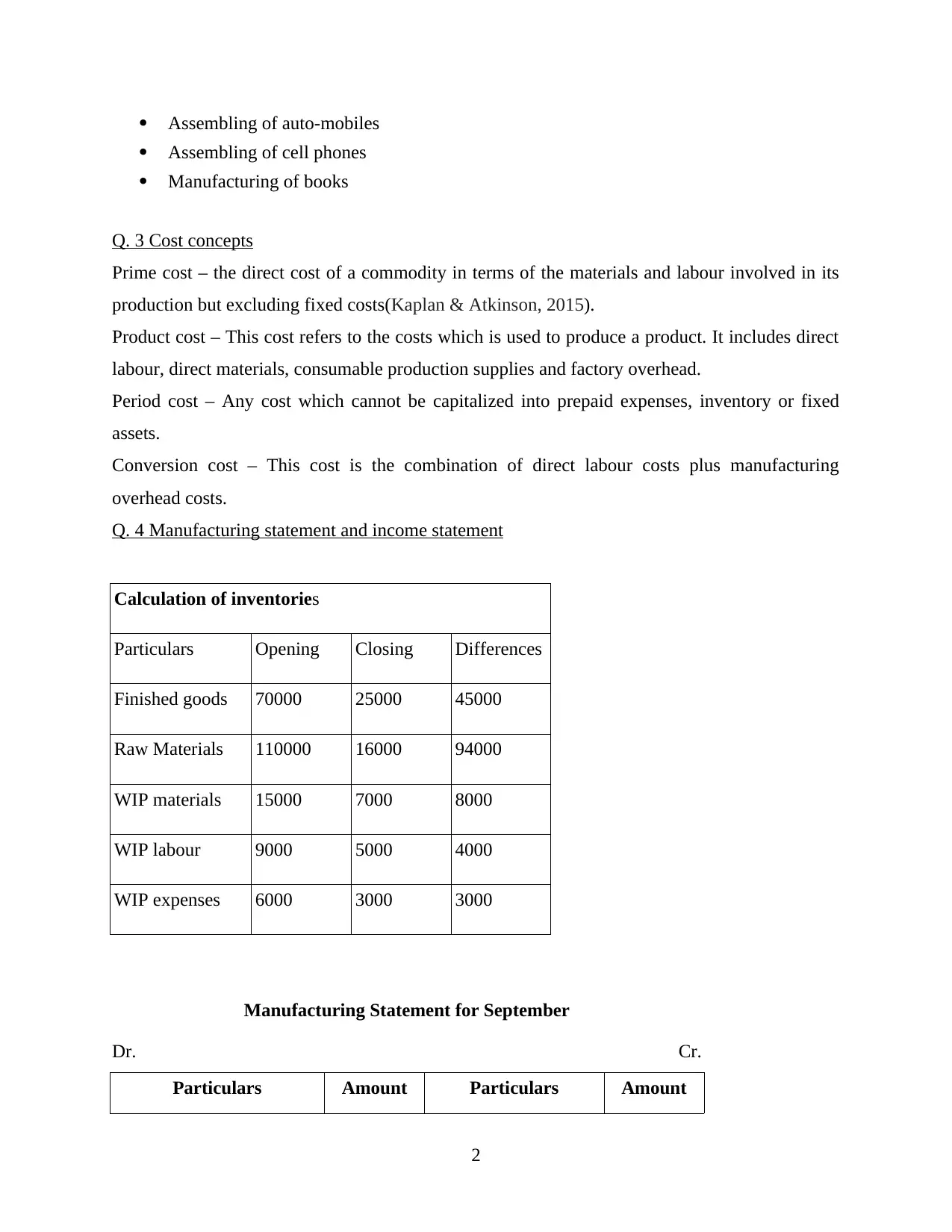
Assembling of auto-mobiles
Assembling of cell phones
Manufacturing of books
Q. 3 Cost concepts
Prime cost – the direct cost of a commodity in terms of the materials and labour involved in its
production but excluding fixed costs(Kaplan & Atkinson, 2015).
Product cost – This cost refers to the costs which is used to produce a product. It includes direct
labour, direct materials, consumable production supplies and factory overhead.
Period cost – Any cost which cannot be capitalized into prepaid expenses, inventory or fixed
assets.
Conversion cost – This cost is the combination of direct labour costs plus manufacturing
overhead costs.
Q. 4 Manufacturing statement and income statement
Calculation of inventories
Particulars Opening Closing Differences
Finished goods 70000 25000 45000
Raw Materials 110000 16000 94000
WIP materials 15000 7000 8000
WIP labour 9000 5000 4000
WIP expenses 6000 3000 3000
Manufacturing Statement for September
Dr. Cr.
Particulars Amount Particulars Amount
2
Assembling of cell phones
Manufacturing of books
Q. 3 Cost concepts
Prime cost – the direct cost of a commodity in terms of the materials and labour involved in its
production but excluding fixed costs(Kaplan & Atkinson, 2015).
Product cost – This cost refers to the costs which is used to produce a product. It includes direct
labour, direct materials, consumable production supplies and factory overhead.
Period cost – Any cost which cannot be capitalized into prepaid expenses, inventory or fixed
assets.
Conversion cost – This cost is the combination of direct labour costs plus manufacturing
overhead costs.
Q. 4 Manufacturing statement and income statement
Calculation of inventories
Particulars Opening Closing Differences
Finished goods 70000 25000 45000
Raw Materials 110000 16000 94000
WIP materials 15000 7000 8000
WIP labour 9000 5000 4000
WIP expenses 6000 3000 3000
Manufacturing Statement for September
Dr. Cr.
Particulars Amount Particulars Amount
2
Paraphrase This Document
Need a fresh take? Get an instant paraphrase of this document with our AI Paraphraser
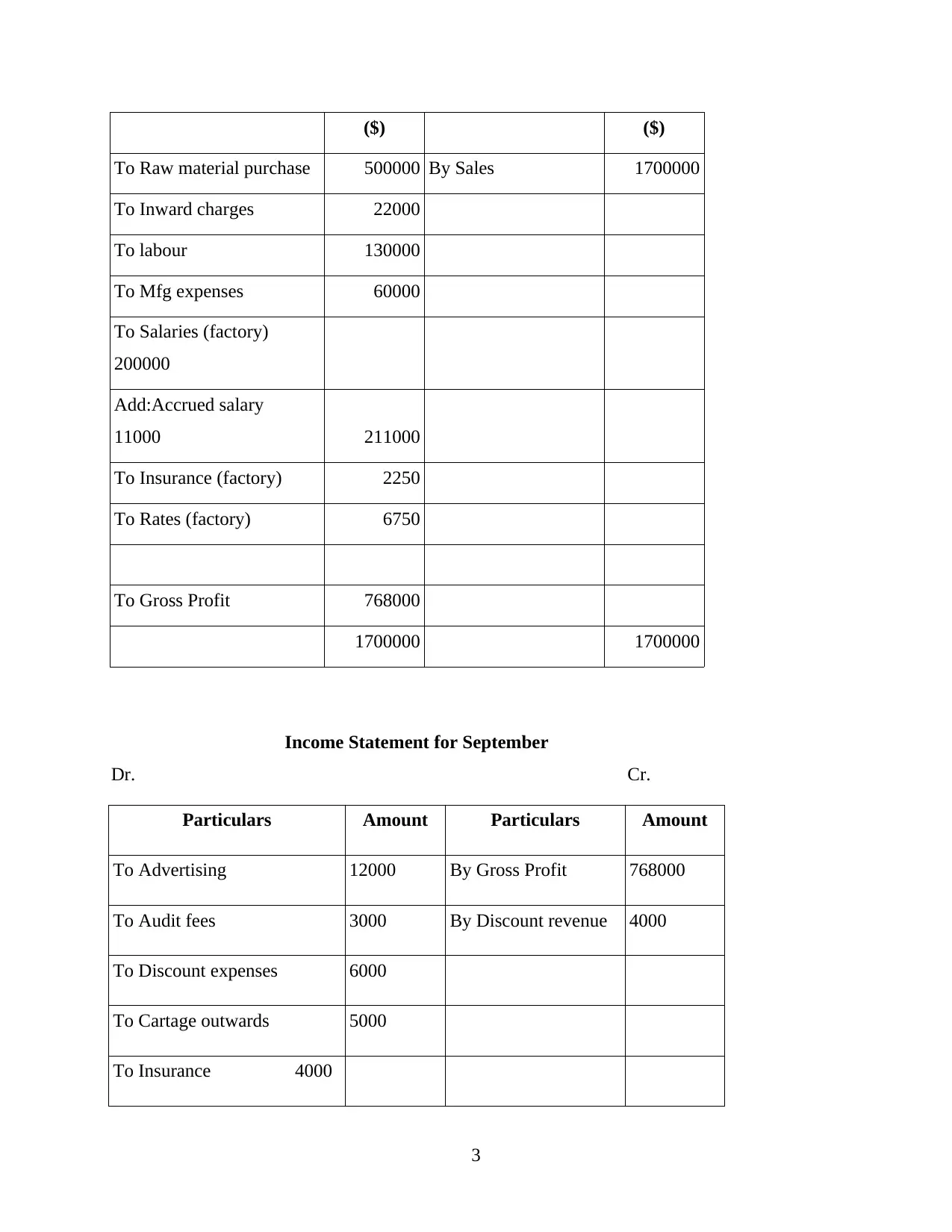
($) ($)
To Raw material purchase 500000 By Sales 1700000
To Inward charges 22000
To labour 130000
To Mfg expenses 60000
To Salaries (factory)
200000
Add:Accrued salary
11000 211000
To Insurance (factory) 2250
To Rates (factory) 6750
To Gross Profit 768000
1700000 1700000
Income Statement for September
Dr. Cr.
Particulars Amount Particulars Amount
To Advertising 12000 By Gross Profit 768000
To Audit fees 3000 By Discount revenue 4000
To Discount expenses 6000
To Cartage outwards 5000
To Insurance 4000
3
To Raw material purchase 500000 By Sales 1700000
To Inward charges 22000
To labour 130000
To Mfg expenses 60000
To Salaries (factory)
200000
Add:Accrued salary
11000 211000
To Insurance (factory) 2250
To Rates (factory) 6750
To Gross Profit 768000
1700000 1700000
Income Statement for September
Dr. Cr.
Particulars Amount Particulars Amount
To Advertising 12000 By Gross Profit 768000
To Audit fees 3000 By Discount revenue 4000
To Discount expenses 6000
To Cartage outwards 5000
To Insurance 4000
3
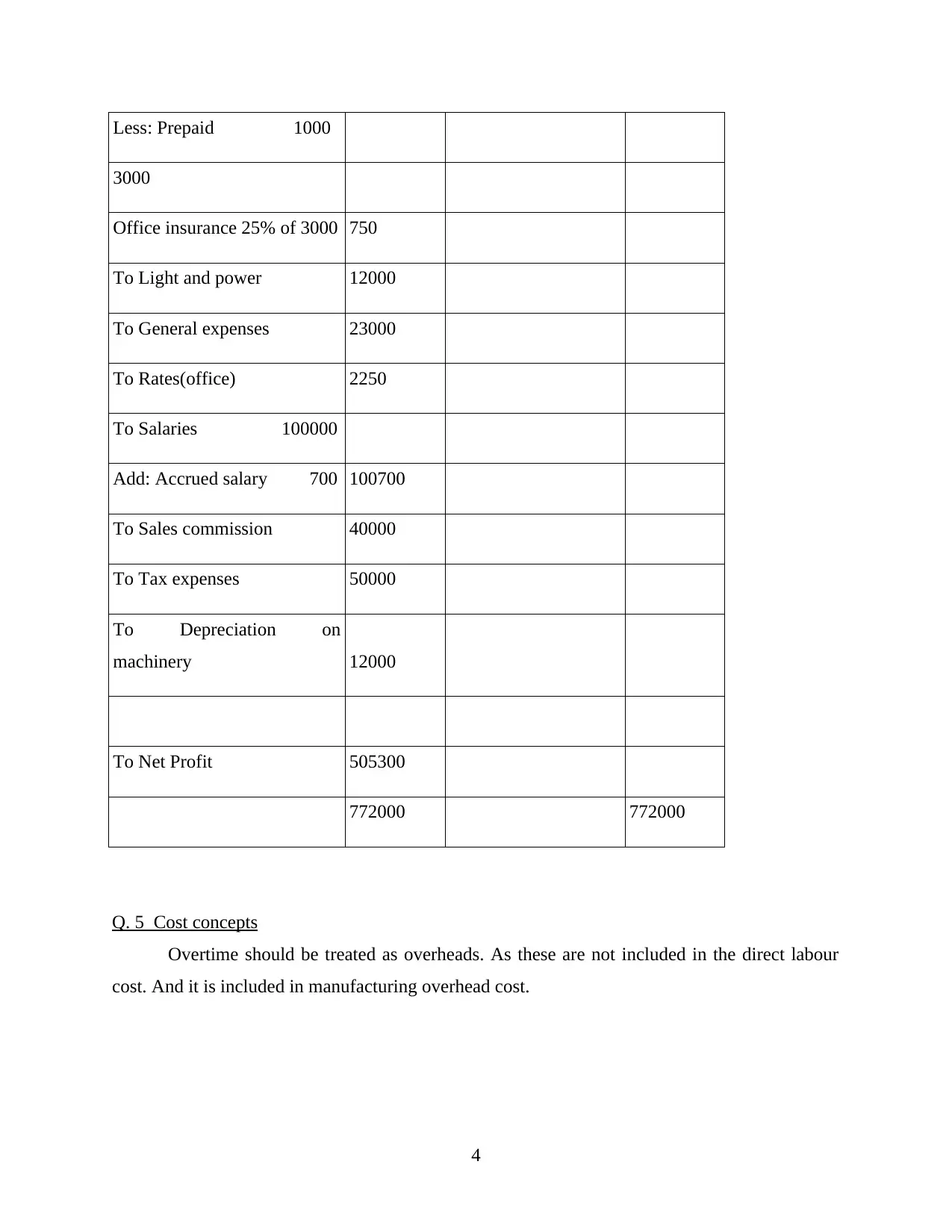
Less: Prepaid 1000
3000
Office insurance 25% of 3000 750
To Light and power 12000
To General expenses 23000
To Rates(office) 2250
To Salaries 100000
Add: Accrued salary 700 100700
To Sales commission 40000
To Tax expenses 50000
To Depreciation on
machinery 12000
To Net Profit 505300
772000 772000
Q. 5 Cost concepts
Overtime should be treated as overheads. As these are not included in the direct labour
cost. And it is included in manufacturing overhead cost.
4
3000
Office insurance 25% of 3000 750
To Light and power 12000
To General expenses 23000
To Rates(office) 2250
To Salaries 100000
Add: Accrued salary 700 100700
To Sales commission 40000
To Tax expenses 50000
To Depreciation on
machinery 12000
To Net Profit 505300
772000 772000
Q. 5 Cost concepts
Overtime should be treated as overheads. As these are not included in the direct labour
cost. And it is included in manufacturing overhead cost.
4
⊘ This is a preview!⊘
Do you want full access?
Subscribe today to unlock all pages.

Trusted by 1+ million students worldwide
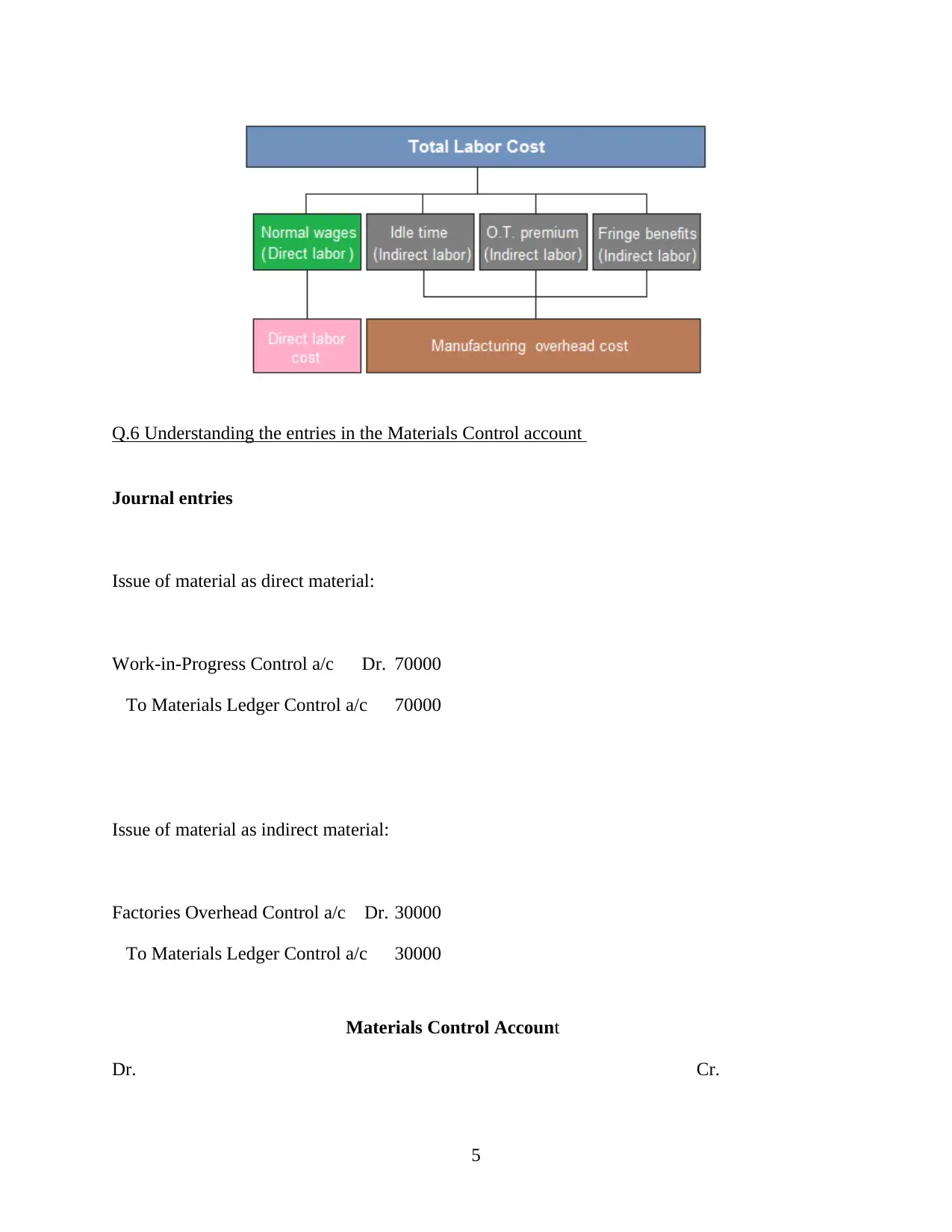
Q.6 Understanding the entries in the Materials Control account
Journal entries
Issue of material as direct material:
Work-in-Progress Control a/c Dr. 70000
To Materials Ledger Control a/c 70000
Issue of material as indirect material:
Factories Overhead Control a/c Dr. 30000
To Materials Ledger Control a/c 30000
Materials Control Account
Dr. Cr.
5
Journal entries
Issue of material as direct material:
Work-in-Progress Control a/c Dr. 70000
To Materials Ledger Control a/c 70000
Issue of material as indirect material:
Factories Overhead Control a/c Dr. 30000
To Materials Ledger Control a/c 30000
Materials Control Account
Dr. Cr.
5
Paraphrase This Document
Need a fresh take? Get an instant paraphrase of this document with our AI Paraphraser
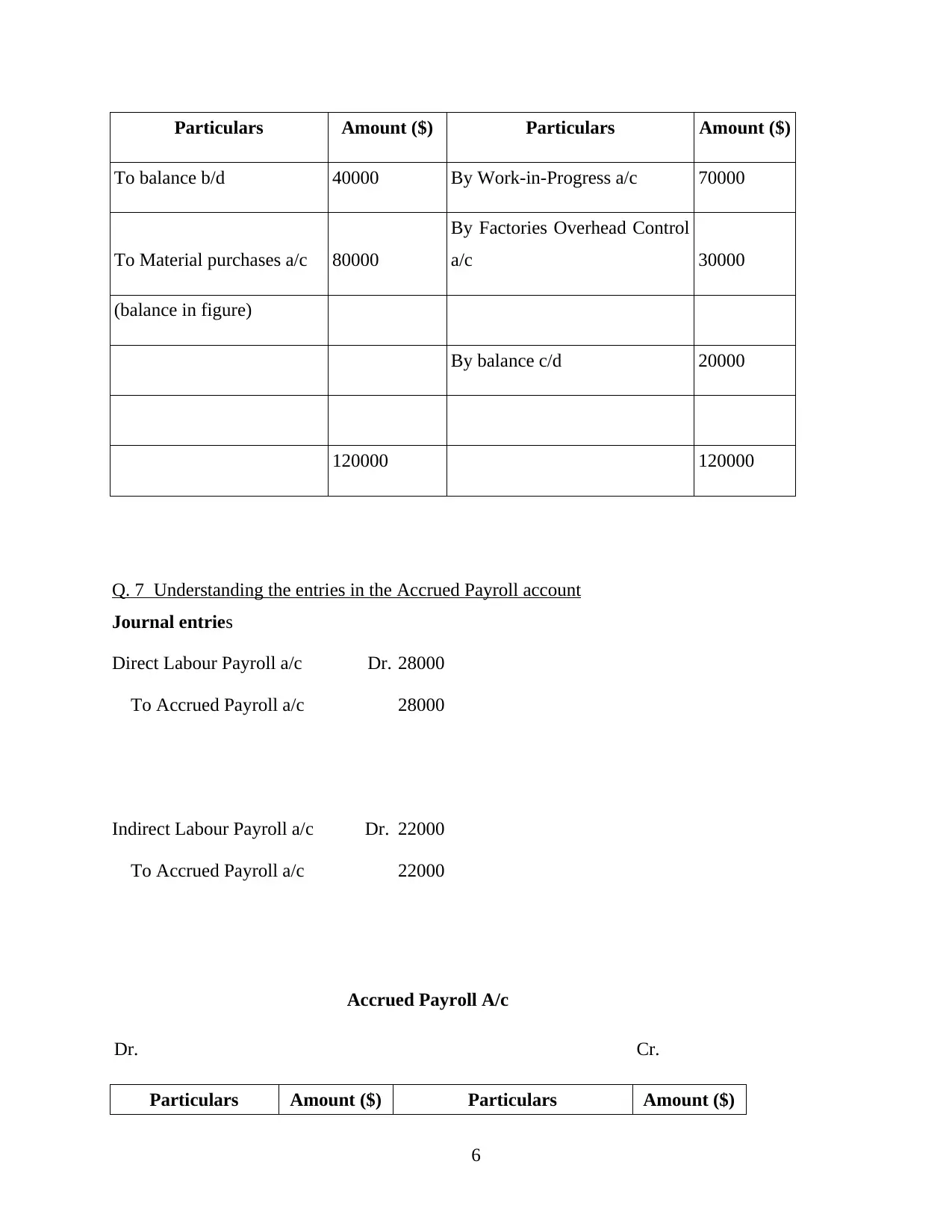
Particulars Amount ($) Particulars Amount ($)
To balance b/d 40000 By Work-in-Progress a/c 70000
To Material purchases a/c 80000
By Factories Overhead Control
a/c 30000
(balance in figure)
By balance c/d 20000
120000 120000
Q. 7 Understanding the entries in the Accrued Payroll account
Journal entries
Direct Labour Payroll a/c Dr. 28000
To Accrued Payroll a/c 28000
Indirect Labour Payroll a/c Dr. 22000
To Accrued Payroll a/c 22000
Accrued Payroll A/c
Dr. Cr.
Particulars Amount ($) Particulars Amount ($)
6
To balance b/d 40000 By Work-in-Progress a/c 70000
To Material purchases a/c 80000
By Factories Overhead Control
a/c 30000
(balance in figure)
By balance c/d 20000
120000 120000
Q. 7 Understanding the entries in the Accrued Payroll account
Journal entries
Direct Labour Payroll a/c Dr. 28000
To Accrued Payroll a/c 28000
Indirect Labour Payroll a/c Dr. 22000
To Accrued Payroll a/c 22000
Accrued Payroll A/c
Dr. Cr.
Particulars Amount ($) Particulars Amount ($)
6
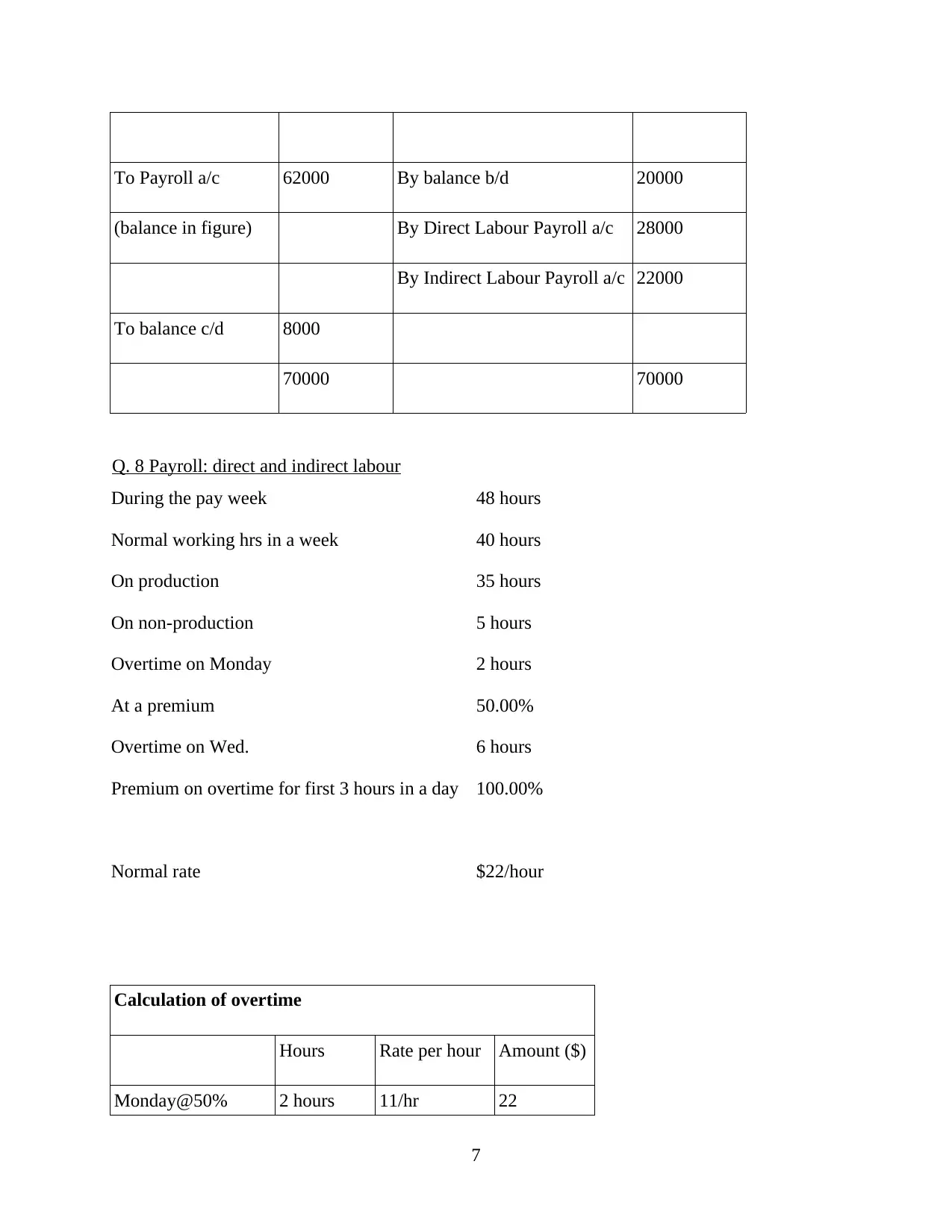
To Payroll a/c 62000 By balance b/d 20000
(balance in figure) By Direct Labour Payroll a/c 28000
By Indirect Labour Payroll a/c 22000
To balance c/d 8000
70000 70000
Q. 8 Payroll: direct and indirect labour
During the pay week 48 hours
Normal working hrs in a week 40 hours
On production 35 hours
On non-production 5 hours
Overtime on Monday 2 hours
At a premium 50.00%
Overtime on Wed. 6 hours
Premium on overtime for first 3 hours in a day 100.00%
Normal rate $22/hour
Calculation of overtime
Hours Rate per hour Amount ($)
Monday@50% 2 hours 11/hr 22
7
(balance in figure) By Direct Labour Payroll a/c 28000
By Indirect Labour Payroll a/c 22000
To balance c/d 8000
70000 70000
Q. 8 Payroll: direct and indirect labour
During the pay week 48 hours
Normal working hrs in a week 40 hours
On production 35 hours
On non-production 5 hours
Overtime on Monday 2 hours
At a premium 50.00%
Overtime on Wed. 6 hours
Premium on overtime for first 3 hours in a day 100.00%
Normal rate $22/hour
Calculation of overtime
Hours Rate per hour Amount ($)
Monday@50% 2 hours 11/hr 22
7
⊘ This is a preview!⊘
Do you want full access?
Subscribe today to unlock all pages.

Trusted by 1+ million students worldwide
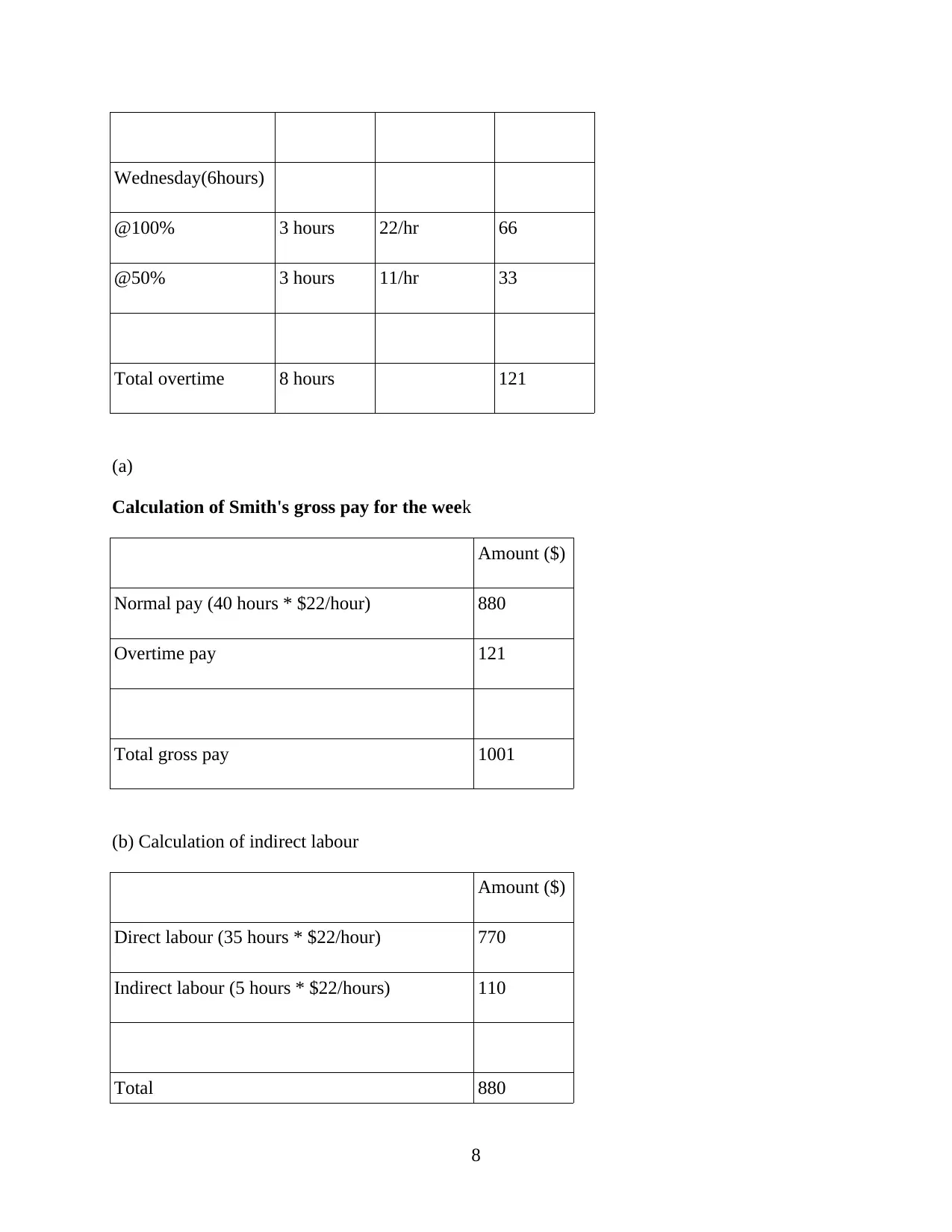
Wednesday(6hours)
@100% 3 hours 22/hr 66
@50% 3 hours 11/hr 33
Total overtime 8 hours 121
(a)
Calculation of Smith's gross pay for the week
Amount ($)
Normal pay (40 hours * $22/hour) 880
Overtime pay 121
Total gross pay 1001
(b) Calculation of indirect labour
Amount ($)
Direct labour (35 hours * $22/hour) 770
Indirect labour (5 hours * $22/hours) 110
Total 880
8
@100% 3 hours 22/hr 66
@50% 3 hours 11/hr 33
Total overtime 8 hours 121
(a)
Calculation of Smith's gross pay for the week
Amount ($)
Normal pay (40 hours * $22/hour) 880
Overtime pay 121
Total gross pay 1001
(b) Calculation of indirect labour
Amount ($)
Direct labour (35 hours * $22/hour) 770
Indirect labour (5 hours * $22/hours) 110
Total 880
8
Paraphrase This Document
Need a fresh take? Get an instant paraphrase of this document with our AI Paraphraser
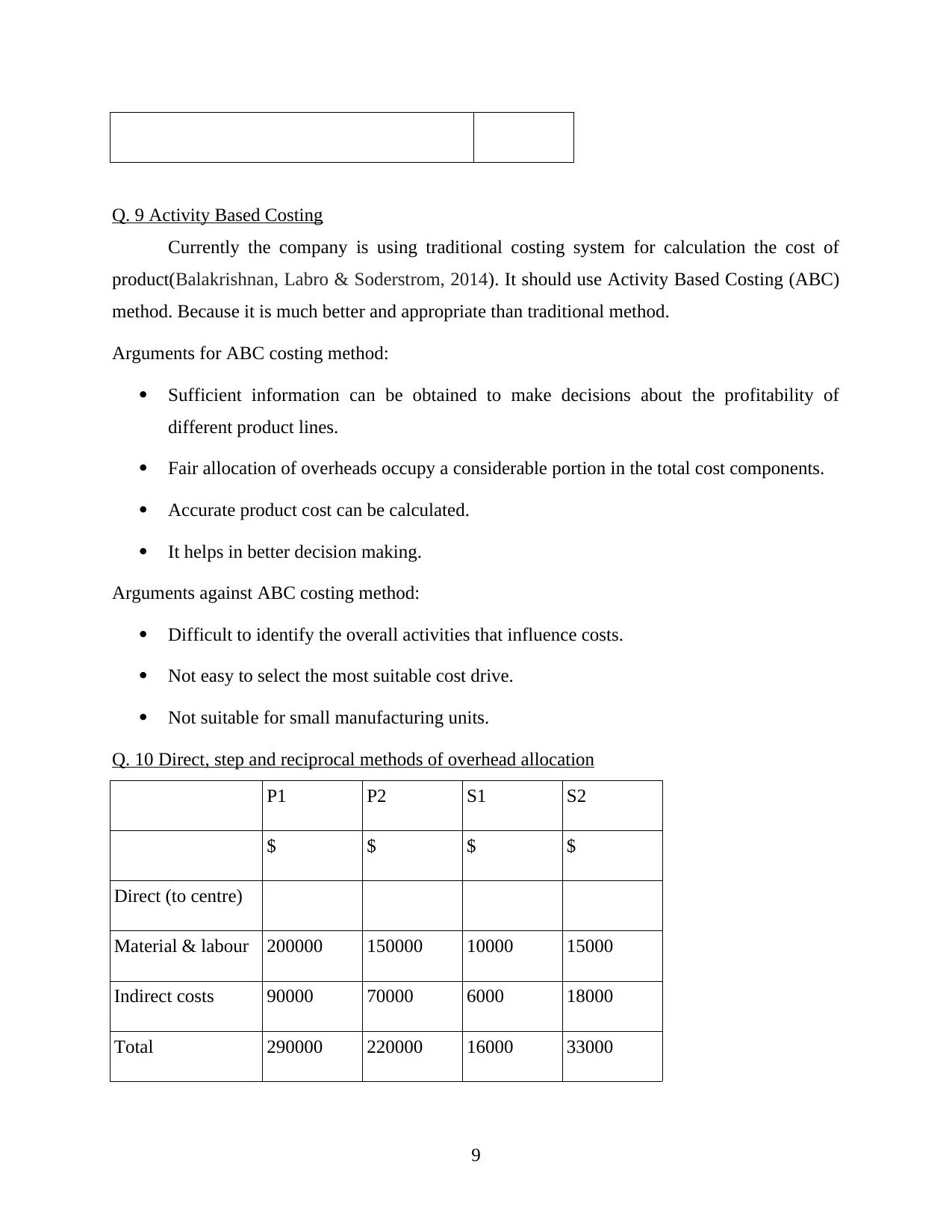
Q. 9 Activity Based Costing
Currently the company is using traditional costing system for calculation the cost of
product(Balakrishnan, Labro & Soderstrom, 2014). It should use Activity Based Costing (ABC)
method. Because it is much better and appropriate than traditional method.
Arguments for ABC costing method:
Sufficient information can be obtained to make decisions about the profitability of
different product lines.
Fair allocation of overheads occupy a considerable portion in the total cost components.
Accurate product cost can be calculated.
It helps in better decision making.
Arguments against ABC costing method:
Difficult to identify the overall activities that influence costs.
Not easy to select the most suitable cost drive.
Not suitable for small manufacturing units.
Q. 10 Direct, step and reciprocal methods of overhead allocation
P1 P2 S1 S2
$ $ $ $
Direct (to centre)
Material & labour 200000 150000 10000 15000
Indirect costs 90000 70000 6000 18000
Total 290000 220000 16000 33000
9
Currently the company is using traditional costing system for calculation the cost of
product(Balakrishnan, Labro & Soderstrom, 2014). It should use Activity Based Costing (ABC)
method. Because it is much better and appropriate than traditional method.
Arguments for ABC costing method:
Sufficient information can be obtained to make decisions about the profitability of
different product lines.
Fair allocation of overheads occupy a considerable portion in the total cost components.
Accurate product cost can be calculated.
It helps in better decision making.
Arguments against ABC costing method:
Difficult to identify the overall activities that influence costs.
Not easy to select the most suitable cost drive.
Not suitable for small manufacturing units.
Q. 10 Direct, step and reciprocal methods of overhead allocation
P1 P2 S1 S2
$ $ $ $
Direct (to centre)
Material & labour 200000 150000 10000 15000
Indirect costs 90000 70000 6000 18000
Total 290000 220000 16000 33000
9
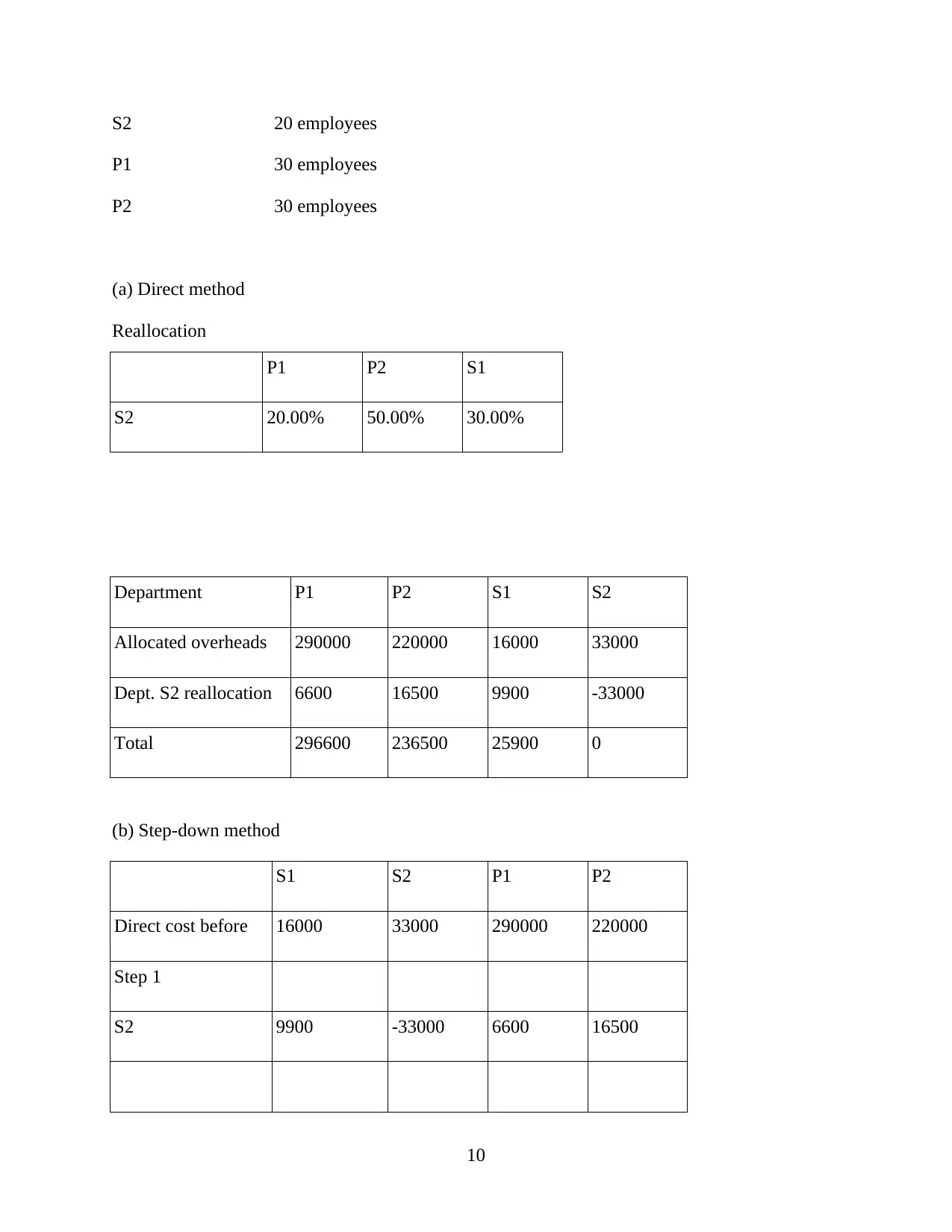
S2 20 employees
P1 30 employees
P2 30 employees
(a) Direct method
Reallocation
P1 P2 S1
S2 20.00% 50.00% 30.00%
Department P1 P2 S1 S2
Allocated overheads 290000 220000 16000 33000
Dept. S2 reallocation 6600 16500 9900 -33000
Total 296600 236500 25900 0
(b) Step-down method
S1 S2 P1 P2
Direct cost before 16000 33000 290000 220000
Step 1
S2 9900 -33000 6600 16500
10
P1 30 employees
P2 30 employees
(a) Direct method
Reallocation
P1 P2 S1
S2 20.00% 50.00% 30.00%
Department P1 P2 S1 S2
Allocated overheads 290000 220000 16000 33000
Dept. S2 reallocation 6600 16500 9900 -33000
Total 296600 236500 25900 0
(b) Step-down method
S1 S2 P1 P2
Direct cost before 16000 33000 290000 220000
Step 1
S2 9900 -33000 6600 16500
10
⊘ This is a preview!⊘
Do you want full access?
Subscribe today to unlock all pages.

Trusted by 1+ million students worldwide
1 out of 12
Related Documents
Your All-in-One AI-Powered Toolkit for Academic Success.
+13062052269
info@desklib.com
Available 24*7 on WhatsApp / Email
![[object Object]](/_next/static/media/star-bottom.7253800d.svg)
Unlock your academic potential
Copyright © 2020–2025 A2Z Services. All Rights Reserved. Developed and managed by ZUCOL.





